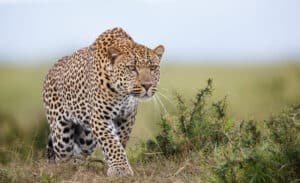Key Points
- Leopards and cheetahs are big cats and some of Africa’s top predators.
- Both of these felines have dark spots covering their tan fur but the spots differ.
- Cheetahs rely on their speed to hunt prey, while leopards use stealth and camouflage.
The leopard and the cheetah are two of Africa’s top predators. Both are big cats and rivals for such prey as Thompson’s gazelles and other small antelopes. Both are beautiful, powerful, and endangered animals, but there are also striking differences between them.
Though they are spotted cats, leopards and cheetahs aren’t that closely related. The leopard belongs to the Panthera genus, along with the lion, the tiger, and the jaguar. The cheetah is the only member of the Acinonyx genus. Its closest relative in the cat family is probably the cougar.
The leopard is stronger than a cheetah and indeed, leopards and lions often kill cheetah cubs to remove them as future competition. On the other hand, the cheetah is famously faster than the leopard for short distances and is one of the fastest land animals on earth. Despite its speed, the cheetah is not as good a hunter as the leopard. The leopard is not only bigger and stronger but patiently stalks its prey. Cheetahs are also tamable and sometimes kept as pets for people who know how to take care of these surprisingly fragile and demanding animals. The much less biddable leopard is never kept as a pet. Read on for some more comparisons between the leopard and the cheetah.
Comparing Leopard vs Cheetah
| Leopard | Cheetah | |
|---|---|---|
| Size | 5.25 to 7.55 feet long | 3.6 to 5 feet long |
| Weight | 37.4 to 143 pounds | 46 to 159 pounds |
| Habitat | Savannas, forests, woods | Grasslands, deserts |
| Lifespan | 10 to 12 years in the wild; up to 27 years in captivity | 8 years in the wild; 17 years in captivity |
| Body | Muscular, head broad, and legs | Long, slim, flexible body, head short in proportion to the body small, legs and tail long |
| Group | Solitary Males form groups | Solitary, except for mothers with cubs |
| Claws | Fully retractable | Somewhat retractable |
| Voice | Roars, growls, purrs, coughs | Churrs, yips, gurgles |
| Active | Nocturnal | Diurnal |
Differences Unique to the Species
Leopards have rosettes on their body and a ringed tail that is shorter than their body. Their fur is thick and soft, especially on the belly. Leopards are also largely arboreal, which means they spend lots of time in trees. There are eight subspecies of leopards.
There are five cheetah subspecies. They have individual spots on their body instead of rosettes, their fur is coarse, and they may have a short mane. Their long limbs and extremely flexible spine allow them to run fast. They also have stripes that run from their eyes and down their cheeks. Though cheetahs can climb trees, they are most often found on the ground.
The Five Key Differences Between Leopards and Cheetahs
1. Leopard vs Cheetah: Different Ranges
Leopards have a wider geographic range than cheetahs. The cheetah’s original native habitat ranged from much of the continent of Africa up into western Asia and as far east as India. The geographic range of leopards also covers much of Africa but also includes Arabia, Java, India, Sri Lanka, Russia, and parts of China.
2. Leopard vs Cheetah: Cheetahs Are Faster Than Leopards, But Leopards Are Stealthier Than Cheetahs
A cheetah can sprint at up to 80 miles per hour but gets overheated after only a few minutes. It will start after prey when it’s as far as 230 to 328 feet away. A leopard takes time to stalk its prey, and its spots help camouflage it. It will then leap on prey when it’s only 9.8 to 33 feet away. If the prey escapes, the leopard probably won’t bother to run after it. Leopards also drop down on unsuspecting prey from trees.
3. Leopard vs Cheetah: Leopards Roar, Cheetahs Chirp
One of the reasons that leopards and cheetahs aren’t in the same genus is their vocalizations. Panthera is the genus of roaring cats. Leopards have a range of vocalizations, including roaring, grunting, spitting, purring, and even meowing. They give a sort of cough that tells other leopards that they’re in the area.
Cheetahs communicate through chortles, chirps, yowls, hisses, growls, moans, meows, and gurgles, but not roars.
4. Leopard vs Cheetah: Male Cheetahs Form Coalitions, Male Leopards Don’t
Male cheetahs often form coalitions to defend their mutual territory, and these coalitions may last for the life of their members. Males in a coalition are almost always related, and it takes time for an unrelated male to become accepted into the group.
On the other hand, leopards are solitary animals. These felines only spend time in groups during mating season and to raise young.
5. Leopard vs Cheetah: Leopards Hunt at Night, Cheetahs Hunt During the Day
Generally, leopards hunt at night and rest during the day. Cheetahs hunt during the day. This helps them avoid cats that hunt at night, such as the leopard and the lion, but leopards and lions sometimes steal cheetah kills anyway. This is especially unfortunate because cheetahs are not good hunters, and most of their attempts to take down a prey animal fail.
Summary: Cheetah vs Leopard
| Traits | Cheetah | Leopard |
|---|---|---|
| Range | Africa, western Asia, India | Africa, Arabia, Java India, Sri Lanka, Russia, China |
| Hunting Style | Speed, camouflage | Stealth, camouflage |
| Vocalization | Chortle, chirp, yowl, hiss, moan, meow No roar | Roar, grunt, spit, purr, meow |
| Social | Male coalitions | Solitary |
| Time active | Diurnal | Nocturnal |
Up next…
Big cat species often get confused with each other, not just cheetahs and leopards. Here are some other examples:
- Leopard Vs Tiger: Comparing The Big Cat Contenders! – While one has stripes and the other spots, these big cats are similar in many ways.
- Serval vs Cheetah: What are the Differences? – African cats such as these can be easily confused, especially when they look almost identical!
- Puma vs Jaguar: Mountain Feline and Jungle Cat – Jaguars and pumas share ranges but cna be identified as separate through key characteristics.
The photo featured at the top of this post is ©
Thank you for reading! Have some feedback for us? Contact the AZ Animals editorial team.






